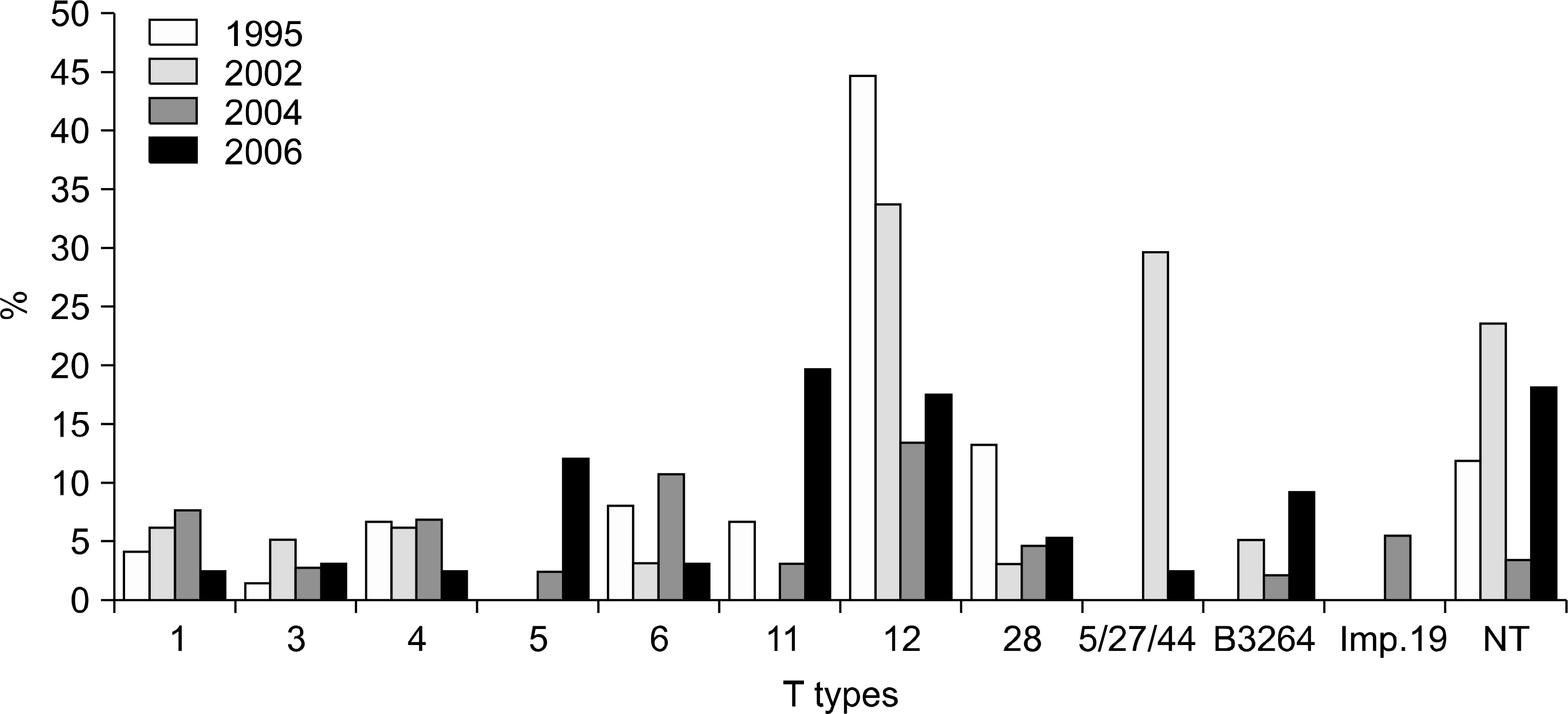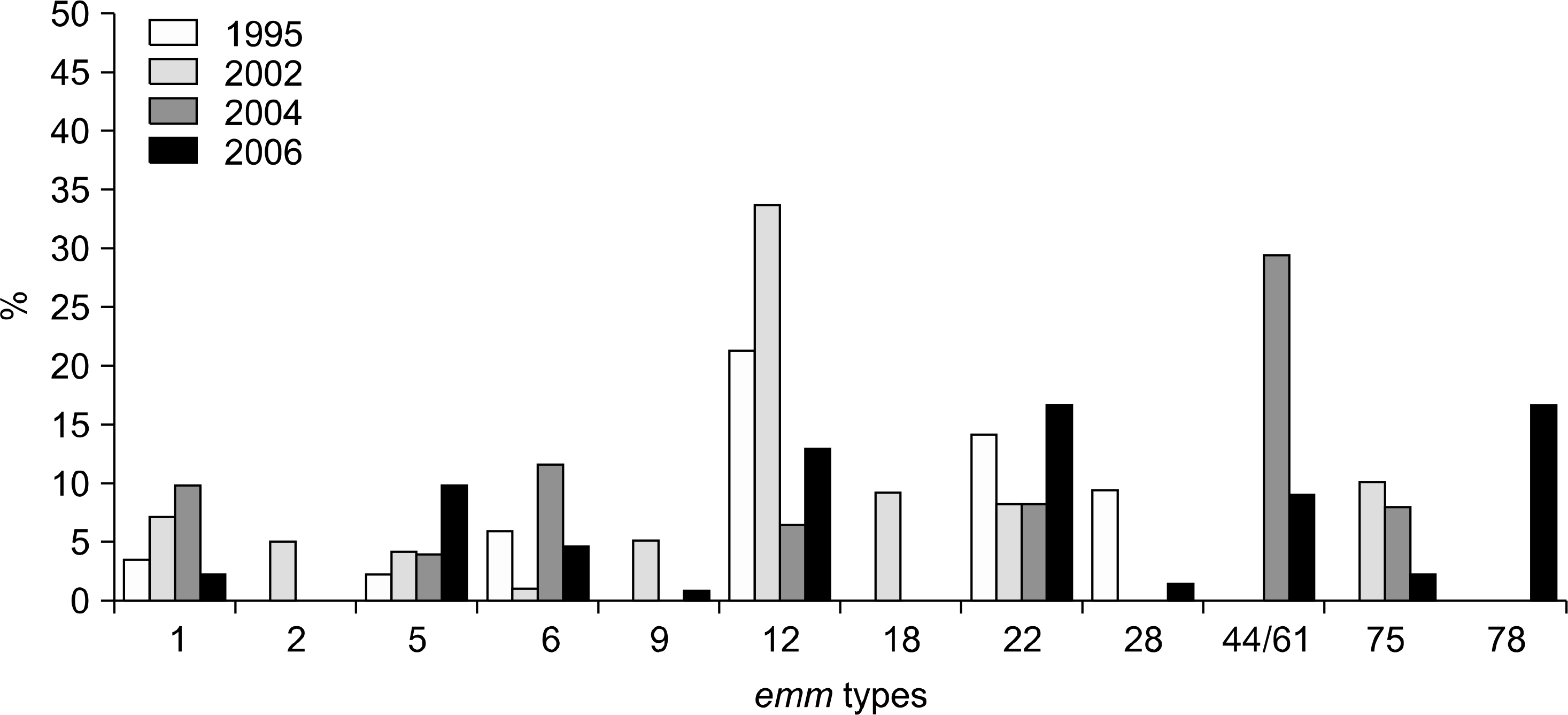Abstract
Background
Streptococcus pyogenes is the most common cause of bacterial pharyngitis. T antigens and emm genotypes are essential markers for an epidemiological study of S. pyogenes. Macrolide resistance of S. pyogenes is a serious obstracle to successfully treating a sore throat.
Methods
One-hundred forty-seven strains of S. pyogenes isolated from healthy school children in 2006 were subjected to T typing and emm genotyping. A disk diffusion method was applied for several antibiotics. A double disk diffusion test was performed to evaluate the phenotype distribution of macrolide resistance.
Results
Among T antigens and emm genotypes, T11 (19.7%) and emm78 (16.7%), respectively, were the most common in 2006. Both T5/27/44 (2.3%) and emm44/61 (9.1%) declined to a great extent from about 29% in 2004. The rate of resistance to antibiotics were 11.6% to erythromycin, 4.8% to clindamycin, 21.8% to tetracycline, and 7.5% to ofloxacin. M and cMLSB phenotypes were 52.9% and 41.2% respectively.
Conclusion
T typing and emm genotyping proved a dynamic change in their distribution in 2006 compared to the results of 2004. Erythromycin and clindamycin resistance remained low as in 2004, whereas ofloxacin resistance increased slightly. M and cMLSB phenotypes were equivalent in 2006, whereas B cMLSB was predominant in 2004.
Go to : 
REFERENCES
1. Bisno AL, Gerber MA, Gwaltney JM Jr, Kaplan EL, Schwartz RH. Practice guidelines for the diagnosis and management of group A streptocccal pharyngitis. Infectious Diseases Society of Amercia. Clin Infect Dis. 2002; 35:113–25.
3. Kim SJ, Lee NY. Epidemiology and antibiotic resistance of group A streptococci isolated from healthy schoolchildren in Korea. J Antimicrob Chemother. 2004; 54:447–50.

4. Kim SJ, Cha SH, Kim EC, Kaplan EL. Serotypes of Streptococcus pyogenes isolated from healthy school children in Kangwon-do. J Korean Med Sci. 1994; 9:52–6.
5. Clinical and Laboratory Standards Institute. Performance standards for antimicrobial susceptibility testing; seventeenth informational supplement. M100-S17. Clinical and Laboratory Standards Institute, Wayne, PA, USA,. 2007.
6. Bassetti M, Manno G, Collida A, Ferrando A, Gatti G, Ugolotii E, et al. Erythromycin resistance in Streptococcus pyogenes in Italy. Emerg Infect Dis. 2000; 6:180–3.
7. Yi YH, Choi JH, Lee HK, Lee KJ, Bae SM, Yu JY, et al. Characterization of erythromycin resistance of Streptococcus pyogenes isolated from pharyngitis patients in Korea. Jpn J Infect Dis. 2006; 59:192–4.
8. Koh EH, Kim S. Evaluation of SD Bioline Strep A for rapid antigen testing in elementary schoolchildren. Korean J Clin Microbiol. 2007; 10:54–8.
9. Seppälä H, Klaukka T, Vuopio-Varkila J, Muotiala A, Helenius H, Lager K, et al. The effect of changes in the consumption of macrolide antibiotics on erythromycin resistance in group A streptococcus in Finland. N Engl J Med. 1997; 337:441–6.
10. Koo H, Baek S, Ma S, Lee H, Cha S. Trends of incidence of erythromycin-resistant group A streptococci in Korea from 1998 through 2002. Infect Chemother. 2004; 36:75–82.
11. Koh EH, Kim S, Lee NY. Decrease of erythromycin resistance in group A streptococci by change of emm distribution. Jpn J Infect Dis. 2008; 61:261–3.
12. Bae SY, Kim JS, Kwon JA, Yoon SY, Lim CS, Lee KN, et al. Phenotypes and genotypes of macrolide-resistant Streptococcus pyogenes isolated in Seoul, Korea. J Med Microbiol. 2007; 56:229–35.
Go to : 
 | Fig. 1.Change in the distribution of T types of Streptococcus pyogenes between 1995∼2006 in Jinju. |
 | Fig. 2.Change in the distribution of emm types of Streptococcus pyogenes between 1995∼2006 in Jinju. |
Table 1.
Antibiotic resistance of Streptococcus pyogenes isolated from three elementary schools in Jinju, 2006
Table 2.
Comparison of antibiotic resistance rates, macrolide resistance phenotypes and genotypes of Streptococcus pyogenes between 1995-2006 in Jinju




 PDF
PDF ePub
ePub Citation
Citation Print
Print


 XML Download
XML Download